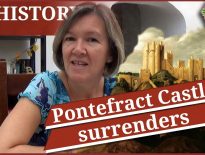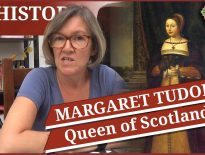By this day in Tudor history, 19th October 1536, the Pilgrimage of Grace Rebellion in the north of England was well underway, and King Henry VIII had come to the decision that tough action was needed to put it down.
The king had refused to give in to the rebels' demands and they had refused to go back to their homes, so on 19th October 1536, the king wrote to Charles Brandon, Duke of Suffolk, and Edward Stanley, Earl of Derby, with instructions on what to do. The letters do not make for easy reading. This was the king at his most brutal. Examples were to be made of people, after all, these people were traitors to the Crown.
Awful.
I give a recap of what the rebellion was about and then share Henry VIII's letters.
Also on this day in history:
- 1469 - Marriage of Ferdinand of Aragon and Isabella of Castile, the famous 'Reyes Católicos' and the parents of Catherine of Aragon, in the Palacio de los Vivero, Valladolid, Spain. Isabella became Queen Isabella I of Castile in 1474 and Ferdinand became King Ferdinand II of Aragon in 1479, so their marriage united the powerful kingdoms of Aragon and Castile, a vast territory which comprised most of what is modern-day Spain.
- 1512 – Reformer Martin Luther was awarded his Doctorate of Theology from the University of Wittenberg.
- 1592 – Death of Anthony Browne, 1st Viscount Montagu, courtier and member of Parliament, at his manor of West Horsley, Surrey, He was buried at Midhurst. Montagu served Mary I as an ambassador and Privy Councillor, and Elizabeth I as Lord Lieutenant of Sussex.



I am both frightened and appalled by this letter from Henry, because it isn’t a command to attack an armed rebellious army but ordinary men, women and children and massacre them, unless they surrender. I doubt Brandon, often described as one of the last true knights in England, wanted to carry out such orders and his replies show him preferring to negotiate. Fortunately, most of the gentlemen in Lincolnshire did surrender, alongside most of their tenants and by the time he had set up his headquarters in Stamford, the vast number of the Lincolnshire rebels had either negotiated or stood down. Thankfully, at this stage this massacre was avoided.
Up North, it was a different matter. Here the rebellion was rapidly spreading and the reprisals seemed likely until Pontefract sided with them. What we do know, however, that the later reprisals were very harsh: not a massacre but certainly terrible punishment. After getting the armies in Yorkshire to go home by way of extensive offers of pardons and negotiation, the famous Christmas spent with Robert Aske, in January 1537, additional risings and attacks on Carlisle and Skipton, which cost a lot of lives, gave Henry the excuse he needed for a crackdown. The exact number is not entirely certain because of unofficial death and punishment but from what can be gleaned from correspondence and recorded trials, about 237 were executed in Yorkshire and Lancashire and Cumbria where the trouble spread and 163_in Lincolnshire and the surrounding areas. This included 70 people all taken and tried as the biggest trouble makers who refused to swear and oath of allegiance, 14 monks who were indeed hung from the towers of Sawley Abbey, which we have visited and believe me, there is an unearthly atmosphere; the main leaders, Robert Aske and three others being hanged in chains at York: Lord Dacre being beheaded, despite his age and illness, the cousins of the Duke of Norfolk being executed, including Margaret Bulmer, who was burned at the stake for treason, her husband being also executed, Sir Francis Brigod was executed, as was Lord Hussey and Sir Robert Constable. We are also told that many of the ordinary people executed were hung in their own gardens or village and no village didn’t suffer one execution at least as an example. This is why the numbers remain unclear. Unofficial execution was not unheard off and Henry’s letters appear to authorise such brutality. Norfolk was a soldier; execution didn’t bother him, but even he was humane to a point. Henry had to write and complain because he merely hung most people without even dismemberment of their bodies, the proscribed punishment for treason. Norfolk was a Catholic, although he was a conformist to the new ways under Henry, so just how he felt about the slaughter of former monks is hard to guess. The fact that he cut them down and buried them against Henry’s orders may give us a clue. The fact Henry’s commanders consistently refused to engage point blank and hesitated over who and how many to execute, advising pardon and negotiation and even moderation shows they had a better idea of what was going on and may have even been appalled at the orders for mass slaughter, showing Henry as having lost it, maybe even lost his mind and in a particularly brutal mood as his throne was threatened in earnest at this time.
Henry Viii was becoming, if he wasn’t one already, the tyrant of his latter years, the Henry of legend, the monster of history.
Yes, I can’t see any other way of looking at these instructions. They are brutal, to say the least. Hanging monks, killing man, woman and child as examples, just despicable and the actions of a tyrant and monster.